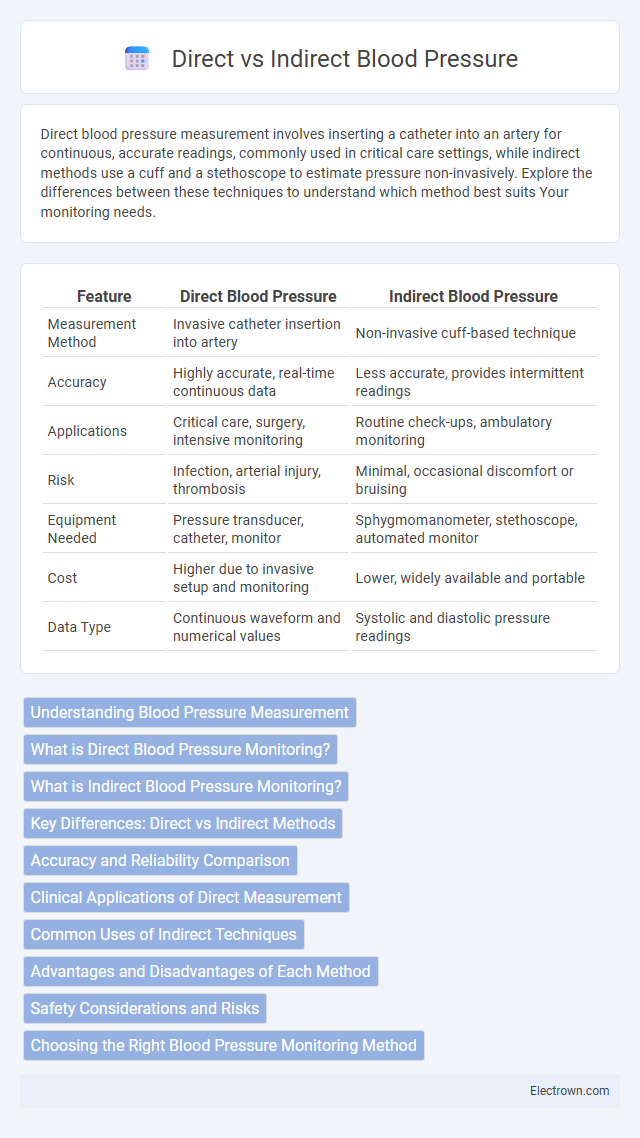Direct blood pressure measurement involves inserting a catheter into an artery for continuous, accurate readings, commonly used in critical care settings, while indirect methods use a cuff and a stethoscope to estimate pressure non-invasively. Explore the differences between these techniques to understand which method best suits Your monitoring needs.
Table of Comparison
| Feature | Direct Blood Pressure | Indirect Blood Pressure |
|---|---|---|
| Measurement Method | Invasive catheter insertion into artery | Non-invasive cuff-based technique |
| Accuracy | Highly accurate, real-time continuous data | Less accurate, provides intermittent readings |
| Applications | Critical care, surgery, intensive monitoring | Routine check-ups, ambulatory monitoring |
| Risk | Infection, arterial injury, thrombosis | Minimal, occasional discomfort or bruising |
| Equipment Needed | Pressure transducer, catheter, monitor | Sphygmomanometer, stethoscope, automated monitor |
| Cost | Higher due to invasive setup and monitoring | Lower, widely available and portable |
| Data Type | Continuous waveform and numerical values | Systolic and diastolic pressure readings |
Understanding Blood Pressure Measurement
Direct blood pressure measurement involves inserting a catheter into an artery to obtain real-time, accurate readings of systolic, diastolic, and mean arterial pressure, commonly used in critical care settings. Indirect blood pressure measurement utilizes a cuff and a sphygmomanometer or automated device to estimate blood pressure non-invasively through oscillometric or auscultatory methods. Understanding the differences in accuracy, invasiveness, and application between these methods is essential for appropriate clinical assessment and patient monitoring.
What is Direct Blood Pressure Monitoring?
Direct blood pressure monitoring involves the continuous measurement of arterial blood pressure using an invasive method, where a catheter is inserted into an artery. This technique provides real-time, highly accurate blood pressure readings, essential in critical care and surgical settings. Your healthcare team relies on this precise data to make immediate and informed decisions about patient management.
What is Indirect Blood Pressure Monitoring?
Indirect blood pressure monitoring measures arterial pressure non-invasively using devices like aneroid sphygmomanometers or automated oscillometric cuffs. It estimates systolic and diastolic pressures by detecting blood flow sounds or oscillations in the brachial artery, typically applied on the upper arm. This method is widely used in clinical settings due to its ease, safety, and suitability for continuous monitoring without arterial catheter insertion.
Key Differences: Direct vs Indirect Methods
Direct blood pressure measurement involves the insertion of a catheter into an artery, providing continuous and accurate real-time readings ideal for critical care settings. Indirect methods utilize external devices like a sphygmomanometer and cuff to estimate blood pressure non-invasively, offering convenience for routine monitoring. Understanding the key differences helps you choose the appropriate technique based on clinical needs, patient condition, and accuracy requirements.
Accuracy and Reliability Comparison
Direct blood pressure measurement provides continuous, real-time data with higher accuracy and reliability, as it involves invasive arterial catheterization that captures true arterial pressure waveforms. Indirect blood pressure methods, such as the oscillometric or auscultatory techniques, are non-invasive and more convenient but can be less accurate due to factors like cuff placement, patient movement, and calibration variability. Clinical settings demanding precise hemodynamic monitoring, such as critical care or surgery, prioritize direct measurement for its superior reliability in detecting transient blood pressure changes.
Clinical Applications of Direct Measurement
Direct blood pressure measurement, also known as invasive blood pressure monitoring, involves inserting a catheter into an artery, providing continuous and accurate real-time data essential for critically ill patients in intensive care units. It is extensively used during major surgeries, such as cardiac and vascular procedures, to closely monitor hemodynamic status and guide fluid and medication management. This method offers superior precision compared to non-invasive techniques, allowing for rapid detection of blood pressure fluctuations and effective titration of vasoactive drugs.
Common Uses of Indirect Techniques
Indirect blood pressure measurement techniques, such as the auscultatory method with a sphygmomanometer and oscillometric devices, are commonly used in clinical settings due to their non-invasive nature and ease of application. These methods are preferred for routine screening, outpatient monitoring, and home blood pressure management, providing reliable estimates without requiring arterial puncture. They are essential tools in managing hypertension, assessing cardiovascular risk, and guiding treatment decisions in primary care.
Advantages and Disadvantages of Each Method
Direct blood pressure measurement provides continuous, real-time data through arterial catheterization, offering high accuracy essential for critical care and surgical settings; however, it carries risks such as infection, thrombosis, and arterial damage. Indirect blood pressure measurement, typically using a cuff and sphygmomanometer or oscillometric device, is non-invasive, easy to perform, and safe for routine monitoring but may be less accurate in patients with arrhythmias or vascular abnormalities. Your choice between these methods should balance the need for precision against potential complications and the clinical context.
Safety Considerations and Risks
Direct blood pressure measurement involves invasive catheter insertion into arteries, posing risks such as infection, arterial damage, and thrombosis, requiring strict sterile techniques to ensure patient safety. Indirect blood pressure methods, like cuff-based oscillometric or auscultatory techniques, minimize physical risk but can yield less accurate data due to factors like improper cuff size or placement. Your choice between direct and indirect monitoring should balance the need for precise hemodynamic data and the potential complications associated with invasive procedures.
Choosing the Right Blood Pressure Monitoring Method
Direct blood pressure measurement involves intra-arterial catheterization providing continuous, accurate readings essential in critical care or surgical settings, while indirect methods, such as oscillometric or auscultatory techniques, offer non-invasive, convenient monitoring suitable for routine blood pressure assessments. The choice between direct and indirect monitoring depends on clinical context, patient condition, and the need for precision versus ease of use. Selecting the appropriate method ensures optimal patient care by balancing accuracy, invasiveness, and practicality.
Direct vs Indirect Blood Pressure Infographic

 electrown.com
electrown.com